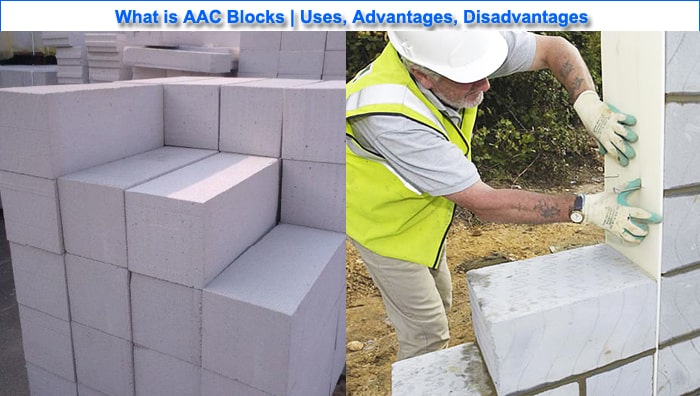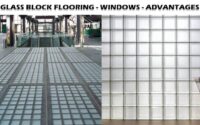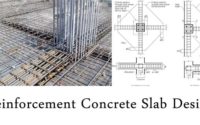All about AAC Blocks | Uses of AAC Block | Advantages and Disadvantages
What Is AAC Block?
Autoclaved aerated concrete block, sometimes known as AAC, is a recent development in the building sector. Cement, sand, lime/gypsum, water, and aluminium powder are the basic ingredients used to make them.
After mixing and moulding, it is then heated and highly pressurised in an autoclave to cure, giving it the desired strength and other special qualities. AAC blocks are non-toxic, recyclable, renewable, and reusable. They are also permeable.
80% of this sort of concrete block is air. The concrete is moulded into larger planks and panels or precisely dimensioned masonry blocks in the manufacturing facility where it is made.
AAC blocks are green, precast building products that are utilised in industrial, commercial, and residential construction.

How are AAC Blocks Created?
- AAC blocks‘ porous, foam-like surfaces are what make them lightweight. That doesn’t mean any magical ingredients had to be used to create it.
- Cement, water, sand, and lime are a few of the components utilised to construct an AAC block. A minor amount of raising agent is additionally included, which helps to create the porous structure.
- AAC blocks are created differently than burned clay bricks and use different materials. A machine called an autoclave can be programmed to generate superheated steam at high pressures and temperatures. The AAC block construction is autoclaved to make it strong and lightweight.
- Now, while the AAC is blended and cast, some ingredients are added to improve the properties of the AAC blocks. Calcium hydroxide and aluminium powder are combined, and the mixture releases water and hydrogen gas. The frothing up of this gas is mostly responsible for the porous, foam-like structure that is created in the end. The gas inside the mixture rises to a height of 3mm, making the finished construction up to three times lighter than a standard cement block.
- The blended slurry solidifies in the autoclave chamber over the course of 10 to 12 hours. AAC is also known as aircrete, porous concrete, cellular concrete, and autoclaved concrete.
Uses Of AAC Blocks
AAC block can be used to build both interior and external walls. Both load-bearing and non-load-bearing walls can use it. AAC blocks are frequently utilised in the construction industry due to their excellent requirements for flexibility and workability.
- High-rise buildings,
- Residential buildings,
- Office/Industrial buildings,
- Hotels, Motels, and Restaurants,
- School/college buildings,
- Hospitals, Medical, Clinics,
- Retail and Warehouse,
- Firewalls and sound walls.
- Cold Storages,
- Auditorium & Theaters
Advantages of AAC Blocks
- The thermal efficiency of these AAC blocks is one of their main advantages. They reduce the need for heating and cooling while maintaining year-round comfort in the home.
- Compared to regular blocks, the blocks are more fire-resistant.
- When compared to traditional clay or cement blocks, the weight of these blocks is up to three times lower.
- Individual blocks are substantially larger than clay bricks. As a result, the building project is completed earlier.
- The cost of AAC blocks is less expensive than using burnt clay bricks for large structures.
- AAC bricks are safe for the environment because they weren’t made with any unfavorable materials. Additionally, the production process results in 30% less solid waste production and 50% less greenhouse gas emissions.
- Because AAC blocks are porous, they naturally absorb moisture, which lowers the amount of mildew, moisture, and humidity inside the home.
- AAC blocks could need more cutting and trimming than regular blocks. However, AAC blocks are more accurate. These are the perfect size, so no trimming is necessary.
- You will pay less for AAC block pricing because these blocks are lightweight when you take into account transportation expenses and labor costs for loading and unloading blocks.
- These breathable, porous materials hold up well over time and are not greatly impacted by climate change.
Disadvantages of AAC Blocks
- The blocks’ structural integrity may crack as a result of improper installation, which will impact the building’s ultimate finish.
- Because AAC blocks are porous, care must be taken when loading and unloading them. Additionally, due to their lightweight, laborers may handle them carelessly, leading to unintended breakage.
- According to the quantity you order, AAC block prices change. When compared to traditional bricks, the overall cost of bricks may be high if you are building a low-rise, small structure. These work best in high-rise structures.
- AAC blocks cannot be laid by any mason. These should only be handled by professionals.
- AAC blocks are referred to as non-load-bearing materials since they cannot support heavy loads. Therefore, partition walls should be the primary application for these.
Frequently Asked Questions (FAQ) on AAC Block:
1. Are AAC blocks good for constructing homes?
AAC blocks are superb in terms of accuracy, toughness, and flexibility. They also offer low-breaking characteristics. These thin blocks have excellent insulating qualities for dwellings in a variety of climates.
2. What is the average AAC block price in India?
AAC blocks typically cost between INR 2,000 and INR 4,000 per cubic meter in India. Each block’s final cost will be entirely determined by its size. Even while the cost seems excessive, keep in mind that these are substantial blocks rather than the usual red bricks.
3. Can you install tiles over AAC blocks?
Yes. To place tiles or other fixtures over these blocks, special adhesives known as AAC block adhesives are intended to be utilised. Other generic adhesives might not function.
4. Why should I use AAC blocks if they are more expensive than red bricks?
Even though red bricks appear to be more expensive than AAC blocks at first glance, choosing the former can result in significant labour, transportation, and cement and steel usage cost savings. AAC blocks’ reduced weight will enable you to cut back on other construction-related expenses.
5. What is the advantage of AAC blocks?
AAC bricks have a number of advantages over conventional blocks, including the fact that they weigh around three times less than cement and clay blocks.
6. Are AAC blocks better than brick?
AAC blocks outlast regular red bricks in terms of durability. Better heat and sound insulation is also a feature. The AAC blocks are lighter and more environmentally friendly than regular bricks, weighing about 80% less.




